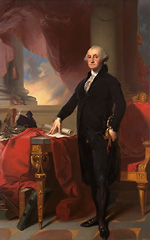Curriculum Materials: Art in America
|
|
Image 6 Thomas Sully Questions: |
Think Questions
1. Is this a heroic image of George Washington? Why or why not? Would the PORTRAIT seem more or less heroic if the President was sitting down? Why? Imagine that Sully had shown Washington smiling. How would this change the effect of the portrait?
2. Why did Sully include CLASSICAL references? Do you see any classical references in your classroom? What are they? Do you think they are SYMBOLIC, decorative, or both? Why?
3. In 1987, the U.S. Congress formally acknowledged the significant historical influence of the Iroquois Confederacy of Nations on the U.S. Constitution. Do you see any references to the Native American Iroquois nations in this PORTRAIT? Why might Sully have neglected to include any references to the Iroquois?
4. Why do you think Sully included the billowing red curtain? The curtain is pulled aside to let in the light of dawn and to reveal a rainbow. What might this SYMBOLIZE in the context of this painting?
5. Sully copied much of this PORTRAIT from a famous painting by another artist, Gilbert Stuart. Why might he have done this? Sully made his copy with Stuart's permission. Why might Stuart have allowed another artist to copy his painting? Do you think a copy of a portrait can be just as truthful as a portrait made from life? Why or why not?
6. Compare Sully's PORTRAIT of George Washington to Copley's formal portrait of Mrs. Nathaniel Allen. In what ways are they alike? What are the major differences? What accounts for these differences? Consider: subjects' positions in early American society, gender, landscape setting vs. interior, props, artistic sources, professional training of artists.
|
|
